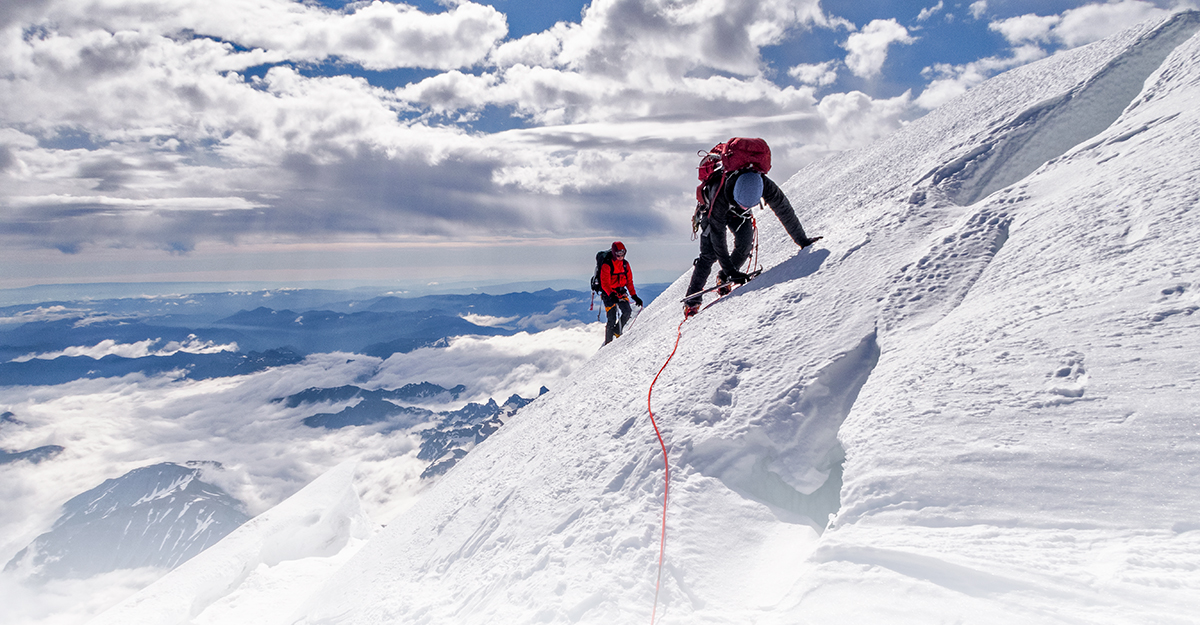
Up Mount Rainier, in John Muir’s Footsteps
A UW alum retraces the famed conservationist’s dangerous climb.
Left foot, right foot, breathe. As I trudge to this slow cadence up the Emmons Glacier, the rising sun starts to color Mount Rainier pink.
My three partners and I are halfway through our summit bid, with 2,500 feet climbed since the early morning and 2,500 yet to go. The glacier is steep, and every step offers us less oxygen than the one before.
I like to think we are following in the footsteps of John Muir x1864, whose climbing party made the sixth recorded ascent of the mountain in 1888. Muir has a legacy here — the camp where climbers depart for the summit on the mountain’s south side is named after him — and his written accounts of his climbs on Rainier and other peaks inspired me to explore the mountains. I picture a scruffy Muir with his long, unkempt beard hiking beside me. An icy gust hits my face and swiftly brings me back to reality.
Mount Rainier sits in the heart of the Cascade Range in Washington State, standing 14,410 feet tall. In a chain of stratovolcanoes, Rainier emerged from the remains of an older, eroded volcano around half a million years ago. Its 25 glaciers, covering more than 35 square miles of the mountain, are mere remnants of the original glaciers that covered Rainier at its birth.
Each year Mount Rainier National Park sees about two million visitors. Roughly 10,000 are climbers, but only half will stand on its peak. More than 400 have died on the mountain since 1897.
My climbing team consists of friends I met after moving from Wisconsin to Montana to work as a reporter at a local newspaper — Matt Baldwin, Patrick Johnston, and Rick Laverty.
While Muir climbed the mountain’s south face — the very popular and ominously named “Disappointment Cleaver” route — we’re following the massive Emmons Glacier on Rainier’s northeast side, taking us up 10,000 feet from car to summit in three days. If all goes according to plan, we will get one full rest day after reaching Camp Schurman on day one. Camp Schurman is the high camp on the Emmons Glacier route, where teams pitch a tent and rest before attempting the summit. Our own summit bid will start in the wee hours of the morning on day three, taking advantage of the time of day when the snow is hard and stable.
Because of the risk of crevasses — large breaks in the glaciers — it’s necessary to stay tied together with a rope, which provides a means of rescue if a member of the team were to break through unstable snow and fall in.
Contemporary mountaineers use gear that is light, trustworthy, and easy to find. Just pop into a nearby recreational equipment store for some boots, an ice ax, and some crampons (metal spikes that attach to mountaineering boots), and you’re set.
Along with those items, I carry a 50-pound backpack with food, clothes, a tent, sleeping bag and pad, first-aid kit, avalanche probe and beacon, shovel, climbing gear, and my helmet. Muir’s team didn’t have these luxuries. When his team hit the Ingraham Glacier on the southeastern flank of the mountain and started to hike across hard snow and ice, Muir and company took off their shoes and drove half-inch steel spikes through the soles. They each also brought an alpenstock — a walking stick with a metal spike at the end — and a collective 100 feet of rope.
I thought about Muir as we left the car to start our climb. After the first few miles, we emerged from thick forest and received our first real glimpse of the mountain and the enormous glaciers we’d soon be hiking. From the trail, the glaciers above seemed to glow blue.
Like Muir, I find that awe draws me to the mountains and keeps me there.
Depending on whom you talk to, Muir was either a mountaineer, an environmentalist, a writer, or one of various other identities. His legacy as a conservationist is most often tied to Teddy Roosevelt or Yosemite National Park, or his wild tale of climbing trees during a storm to gain the forest’s perspective.
Originally from Dunbar, Scotland, Muir and his family emigrated to the United States when he was 11 years old, landing in Kingston, Wisconsin. As a student at the University of Wisconsin, Muir took to two mentors who had a profound impact on his life. Professor James Davie Butler exposed him to the writings of transcendentalists Ralph Waldo Emerson and Henry David Thoreau, and Milton Griswold 1863, MA1866 took the young student into the depths of botany and the natural sciences.
Muir left the UW in 1863, preferring to explore the American West. “I was only leaving one university for another,” he wrote, “the Wisconsin University for the University of the Wilderness.” Thus began Muir’s travels into the mountains and the adventures that made him the man we know today.
We’ve made it halfway up to our high camp, Camp Schurman, when the storms roll in. As we’re roped together on the 2,400-foot-tall Inter Glacier on the northeast face of Mount Rainier, dark clouds around us boom with thunder. After the group ahead of us sees lightning and turns around, we follow suit.
The storm passes without any trouble, but there’s never a bad reason to turn around.
The following day we retrace our steps up the Inter Glacier and reach Camp Schurman by noon. A combination of physical and mental fatigue, along with the fact that I’d never been higher than our elevation at that point (9,500 feet), has worn me down over the course of the day.
We spend the afternoon resting in our tents, listening to music or podcasts, and refueling our bodies with food and water. For me, the meals consist of Pop-Tarts and Clif Bars for breakfast and a freeze-dried dinner: chicken and rice or chicken teriyaki. To my dismay, I’m finding I have trouble eating at altitude. After an early dinner, we head off to bed around 8 p.m. The winds are fierce through the night, and our tent shakes furiously while we lie wide awake.
At 1 a.m. the four of us gather in one tent, where we melt snow to drink, eat our portions, and slowly come to life. Not much is said.
We begin our summit bid by headlamp around 3 a.m.
While crevasses ripple across the giant glacier, they’re easy to spot. In addition, a solid boot path has been established on the route, visible even from far lower elevations, weaving us between breaks in the glacier and up the mountain.
Our pace slows around 13,000 feet, where altitudinal effects start to show. The ascent is long and tiresome. Carrying my heavy pack for the first two days has wiped me out, though we were able to cache some of our gear in a tent at Camp Schurman while we attempt the summit.
At 10 a.m. we crest the northeast side of the caldera, Rainier’s steaming volcanic crater, and follow the ridge to the summit. To the south we see Mount Adams and, behind it, Oregon’s Mount Hood. To the north, a sharp eye can spot Glacier Peak, Mount Baker, and Mount Shuksan. Clouds fill the gaps between the peaks around us.
At the top of Washington State, it dawns on me that I have Muir to thank for this opportunity. He played a key role in seeing this mountain become a national park.
In 1892, Muir cofounded the Sierra Club, one of the first large-scale environmental protection groups. Six years later, he published “The Wild Parks and Forest Reservations of the West,” an article in the Atlantic Monthly promoting the creation of a Mount Rainier National Park, among others. At the time, the area was the Mount Rainier Forest Reserve, but Muir wanted more permanent protections. He wrote, “The icy dome needs none of man’s care, but unless the reserve is guarded the flower bloom will soon be killed, and nothing of the forests will be left but black stump monuments.”
His pleas worked. The following year, Congress established the park. Along with Rainier, Muir played a key role in preserving the Yosemite Valley, Sequoia National Park, and many other wilderness areas.
We stay on the summit for a short time, grabbing photos together and stuffing some food and water in our bodies before heading back down. Naturally, a small blizzard sets in just as we start our descent.
The trip down is long and tedious. Unlike Muir, who had a climbing partner nearly die from a slip on the way down, we are hindered only by the condition of the snow, which has turned to slush in the daylight. Once we return to camp, we immediately pack our things and start moving again.
We return to the cars by 5:30 p.m., emerging from the woods victorious but exhausted. I think we all secretly hope every vacationer and tourist we see in the last few miles of trail will inquire about our adventure so we can turn and point to the blue peak towering above, but everyone just smiles as we hike past them.
Climbing mountains is not fun in any traditional sense of the word. At its best, the fatigue and weather are bearable, and at its worst, every step requires all the energy you have left. Sometimes the views are exceptional, as on Rainier. Other times you summit in a cloud, and the reward at the end of the journey is flat white all around. But what I’ve found on Rainier and dozens of other mountains out west is this: the challenge itself, and the personal struggle that may arise, beat anything else I can think of. Success is never guaranteed, and many things in the mountains are simply out of one’s control. All I can bring is my best, and the gratitude for whatever the mountain will afford me.
Muir understood this feeling, as do all others who endeavor to struggle in the mountains for pleasure. While the picturesque peaks can be appreciated from below, there’s something special about gaining the mountain’s perspective from the summit.
“The view we enjoyed from the summit could hardly be surpassed in sublimity and grandeur; but one feels far from home so high in the sky, so much so that one is inclined to guess that, apart from the acquisition of knowledge and the exhilaration of climbing, more pleasure is to be found at the foot of the mountains than on their tops,” Muir wrote, closing his account of his Rainier climb. “Doubly happy, however, is the man to whom lofty mountain tops are within reach, for the lights that shine there illumine all that lies below.”
Daniel McKay ’16 is a reporter for the Whitefish Pilot, a weekly newspaper in Whitefish, Montana.
Published in the Fall 2019 issue
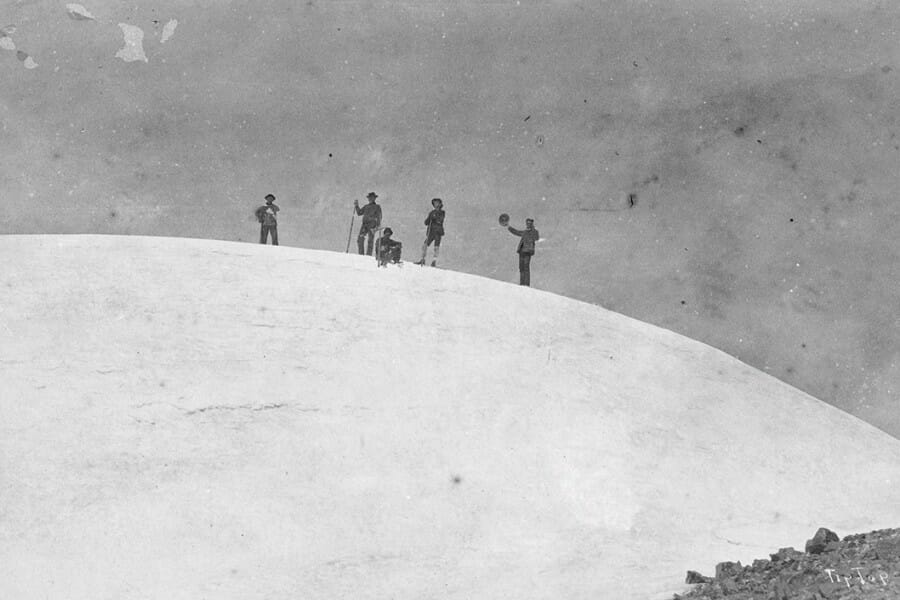
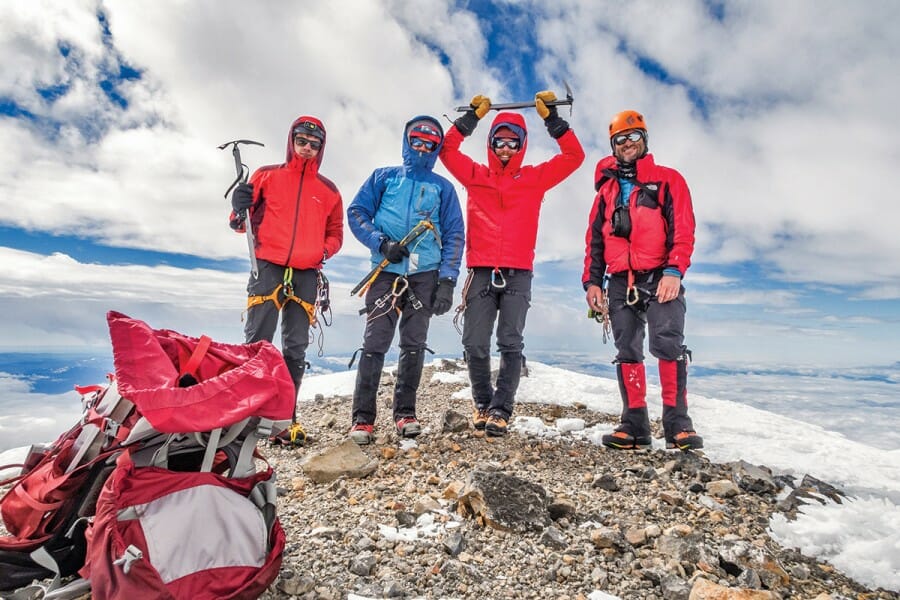
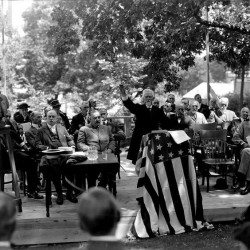
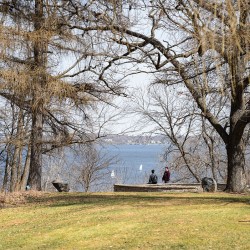
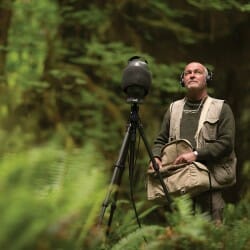
Comments
No comments posted yet.